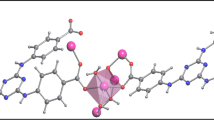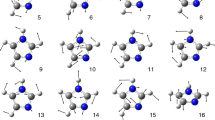Abstract
Some nickel(II) and zinc(II) complexes of the type [Ni(L)(phen/bipy)]X (1a–6a) and [Zn(L) (phen/bipy)]X (1b–6b) (where L = 2-{(E)-[(4-trimethylsilylethynylphenyl)imino]methyl}-4-(4-nitro phenylethynyl)phenol; phen = 1, 10-phenanthroline, bipy = 2, 2´-bipyridine; X = ClO4 −, BF4 −, PF6 −) have been prepared and characterized on the basis of elemental analyses, FTIR, 1H NMR and mass spectral studies. The molecular structure of L was determined by single crystal X-ray diffraction studies. The electrochemical behaviour of the Ni(II) complexes indicate that the phen complexes appears at more positive potential as compared to those for bipy complexes, as a consequence of its strong π-acidic character. TGA was carried out to study the thermal behavior of the complexes. Room temperature luminescence is observed for all complexes corresponds to π → π* ILCT transition. The size of the counter anion and heterocyclic coligands phen and bipy shows marked effect on emission properties of the complexes.









Similar content being viewed by others
References
Andruh M (2011) Compartmental Schiff-base ligands—a rich library of tectons in designing magnetic and luminescent materials. Chem Commun 47:3025–3042
Schull TL, Kuchmerick JG, Patterson CH, George C, Moore MH, Pollack SK, Shashidhar R (2003) Ligand effects on charge transport in platinum(II) Acetylides. J Am Chem Soc 125:3202–3203
Ho KY, Yu WY, Cheung KK, Che CM (1999) Blue luminescent zinc(II) complexes with polypyridylamine ligands: crystal structures and luminescence properties. J Chem Soc Dalton Trans:1581–1586
Lacroix PG (2001) Second-order optical nonlinearities in coordination chemistry: the case of bis(salicylaldiminato)metal Schiff Base complexes. Eur J Inorg Chem 2:339–348
Garoufis A, Hadjikakou SK, Hadjiliadis N (2009) Palladium coordination compounds as anti-viral, anti-fungal, anti-microbial and anti-tumor agents. Coord Chem Reviews 253:1384–1397
Shi Q, Xu L, Ji J, Li Y, Wang R, Zhou Z, Cao R, Hong M, Chan ASC (2004) Syntheses and structures of two anion-templated dinuclear cadmium complexes with diamino-binaphthyl Schiff bases as ligands. Inorg Chem Commun 7:1254–1257
Ziessel R (2001) Schiff-based bipyridine ligands. Unusual coordination features and mesomorphic behaviour. Coord Chem Reviews 216–217:195–223
Golcu A, Tumer M, Demirelli H, Wheatley RA (2005) Cd(II) and Cu(II) complexes of polydentate Schiff base ligands: synthesis, characterization, properties and biological activity. Inorg Chimi Acta 358:1785–1797
Bella SD, Oliveri IP, Colombo A, Dragonetti C, Righettob S, Roberto D (2012) An unprecedented switching of the second-order nonlinear optical response in aggregate bis (salicylaldiminato)zinc(II) Schiff-base complexes. Dalton Trans 41:7013–7016
Oliveri IP, Failla S, Malandrinoa G, Bella SD (2011) New molecular architectures by aggregation of tailored zinc(II) Schiff-base complexes. New J Chem 35:2826–2831
Zhou L, Cai P, Feng Y, Cheng J, Xiang H, Liu J, Wu D, Zhou X (2012) Synthesis and photophysical properties of water-soluble sulfonato-salen-type Schiff bases and their applications of fluorescence sensors for Cu2+ in water and living cells. Anal Chim Acta 735:96–106
Consiglio G, Failla S, Finocchiaro P, Oliveri IP, Bella SD (2012) Aggregation properties of bis(salicylaldiminato)zinc(II) Schiff-base complexes and their Lewis acidic character. Dalton Trans 41:387–395
Hai Y, Chen J-J, Zhao P, Lv H, Yu Y, Xu P, Zhang J-L (2011) Luminescent zinc salen complexes as single and two-photon fluorescence subcellular imaging probes. Chem Commun 47:2435–2437
Sano T, Nishio Y, Hamada Y, Takahashi H, Usuki T, Shibata K (2000) Design of conjugated molecular materials for optoelectronics. J Mater Chem 10:157–161
Averseng F, Lacroix PG, Malfant I, Dahana F, Nakatani K (2000) Synthesis, crystal structure and solid state NLO properties of a new chiral bis(salicylaldiminato)nickel(II) Schiff-base complex in a nearly optimized solid state environment. J Mater Chem 10:1013–1018
Nielsen M, Larsen NB, Gothelf KV (2002) Electron transfer reactions of self-assembled monolayers of Thio(Phenylacetylene) n -substituted chiral metal-salen complexes. Langmuir 18:2795–2799
Schmitz C, Pösch P, Thelakkat M, Schmidt H-W, Montali A, Feldman K, Smith P, Weder C (2001) Polymeric light-emitting diodes based on poly(p-phenyleneethynylene), poly(triphenyl diamine) and Spiroquinoxaline. Adv Funct Mater 11:41–46
Liuzzo V, Oberhauser W, Pucci A (2010) Synthesis of new red photoluminescent Zn(II)-salicylaldiminato complex. Inorg Chem Commun 13:686–688
Wallenhorst C, Kehr G, Luftmann H, Frohlich R, Erker G (2008) Bis(iminoethyl)pyridine systems with a pendant alkenyl group part a: cobalt and iron complexes and their catalytic behavior. Organometallics 27:6547–6556
Sunatsuki Y, Motoda Y, Matsumoto N (2002) Copper(II) complexes with multidentate Schiff-base ligands containing imidazole groups: ligand-complex or self-complementary molecule. Coord Chem Reviews 226:199–209
Sousa C, Gameiro P, Freire C, de Castro B (2004) Nickel(II) and copper(II) Schiff base complexes bearing benzo-15-crown-5 functionalities as probes for spectroscopic recognition of lanthanide ions. Polyhedron 23:1401–1408
More MS, Pawal SB, Lolage SR, Chavan SS (2017) Syntheses, structural characterization, luminescence and optical studies of Ni(II) and Zn(II) complexes containing salophen ligand. J Mol Str 1128:419–427
Ardizzoia GA, Brenna S, Durini S, Theirrien B (2015) Synthesis and characterization of luminescent zinc(II) complexes with a N,N-bidentate 1-pyridylimidazo[1,5-a]pyridine ligand. Polyhrdron 90:214–220
Sheldrick GM (2008) A short history of SHELX. Acta Cryst A 64:112–122
Dal H, Suzen Y, Sahin E (2007) Synthesis, spectral studies of salicylidine-pyridines: crystal and molecular structure of 2-[(1E)-2-aza-2-(5-methyl(2-pyridyl)ethenyl)]-4-bromobenzen-1-ol. Spectrochim Acta Part A 67:808–814
Ikiz M, Ispir E, Aytar E, Ulusoy M, Karabug S, Aslantas M, Celik O (2015) Chemical fixation of CO2 into cyclic carbonates by azo-containing Schiff base metal complexes. New J Chem 39:7786–7796
Ziessel R (1996) General method for the preparation of alkyne-functionalized Oligopyridine building blocks. J Org Chem 61:6535–6546
TuÈmer M, Seyin H, Ksal K, Serin S, Digrak M (1999) Antimicrobial activity studies of mononuclear and binuclear mixed-ligand copper(II) complexes derived from Schiff base ligands and 1,10-phenanthroline. Transit Met Chem 24:13–17
Mukherjee A, Chakrabarty R, Ng SW, Patra GK (2010) The syntheses, characterizations, X-ray crystal structures and properties of Cu(I) complexes of a bis-bidentate schiff base ligand. Inorg Chimi Acta 363:1707–1712
Yang R-N, Sun Y-A, Hou Y-M, Hu X-Y, Jin D-M (2000) Synthesis and reactivity of the copper(I) complex containing bis(diphenylphosphino) methane bridging ligands — structure of [Cu4(μ4-S)(dppm)4] (PF6)2·CH2Cl2. Inorg Chimi Acta 304:1–6
Jonh A, Katiyar V, Pang K, Shaikh MM, Nanavati H, Ghosh P (2007) Ni(II) and Cu(II) complexes of phenoxy-ketimine ligands: synthesis, structures and their utility in bulk ring-opening polymerization (ROP) of L-lactide. Polyhedron 26:4033–4044
Ghaffari A, Behzad M, Pooyan M, Rudbari HA, Bruno G (2014) Crystal structures and catalytic performance of three new methoxy substituted salen type nickel(II) Schiff base complexes derived from meso-1,2-diphenyl-1,2-ethylenediamine. J Mol Struct 1063:1–7
Begum MS, Zangrando E, Howlader MBH, Sheikh MC, Miyatake R, Hossain MM, Alam MM, Hasnat MA (2016) Synthesis, characterization, photoluminescence and electrochemical studies of NiII, CuII, ZnII, CdII and PdII complexes of the bidentate S-hexyl-β-N-(2-thienyl) methylenedithiocarbazate ligand. Polyhedron 105:56–61
Eggleston MK, McMillin DR, Koenig KS, Pallenberg A (1997) Steric effects in the ground and excited states of Cu(NN)2+ systems. J Inorg Chem 36:172–176
Roy S, Sarkar BN, Bhar K, Satapathi S, Mitra P, Ghosh BK (2013) Syntheses, structures and luminescence behaviors of zinc(II) complexes containing a tetradentate Schiff base: variation in nuclearity and geometry with th change of halide/ pseudohalide/ carboxylate and counter anion. J Mol Struct 1037:160–169
Zhu Y, Ma Y, Zhu J (2013) The counter anion effect of ion-type phosphorescent dye tris(4,7-diphenyl-1,10-phenanthroline)ruthenium(II) complexes as dopant for light-emitting diodes. J Luminescence 137:198–203
Acknowledgements
We gratefully acknowledge Head, Sophisticated Analytical Instrument Facility Center, IIT, Madras, India for providing single crystal X-ray facilities.
Author information
Authors and Affiliations
Corresponding author
Rights and permissions
About this article
Cite this article
More, M.S., Devkule, S.S. & Chavan, S.S. Ni(II) and Zn(II) Complexes Containing Alkynyl Functionalized Salicylaldimine Ligand and Heterocyclic Coligand: Synthesis, Characterization and Luminescence Properties. J Fluoresc 27, 841–851 (2017). https://doi.org/10.1007/s10895-016-2020-z
Received:
Accepted:
Published:
Issue Date:
DOI: https://doi.org/10.1007/s10895-016-2020-z




